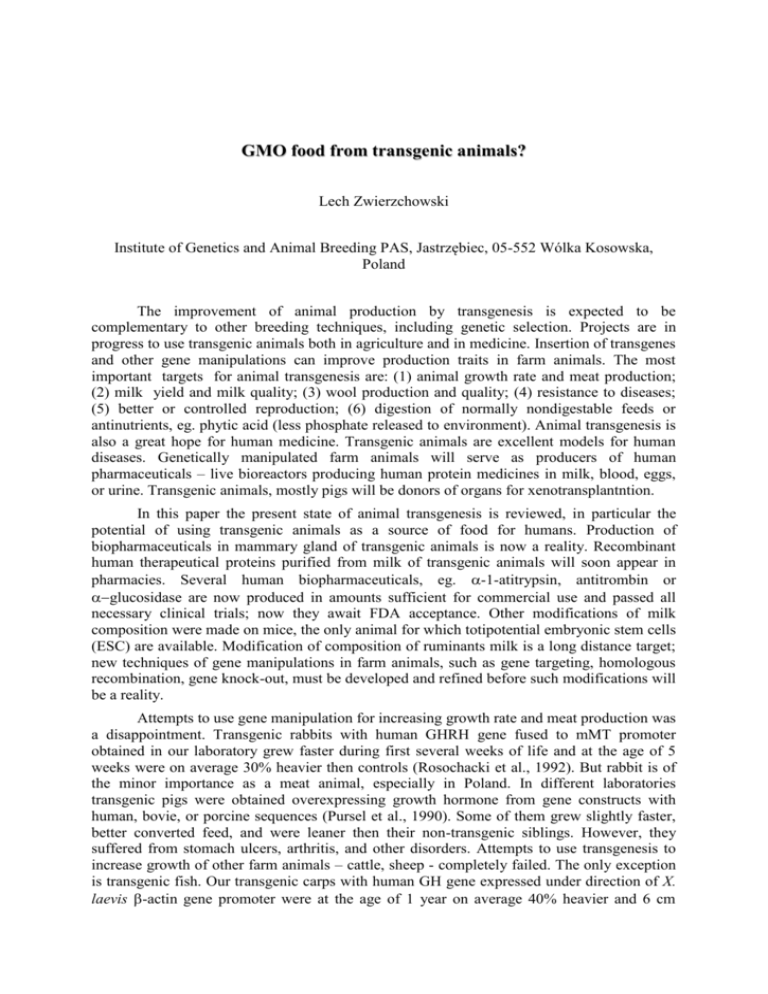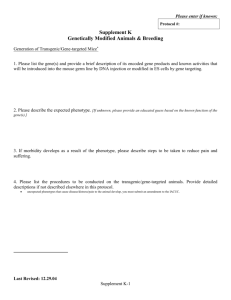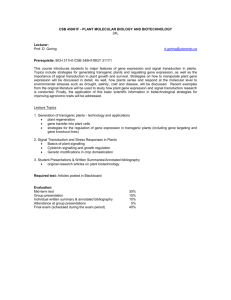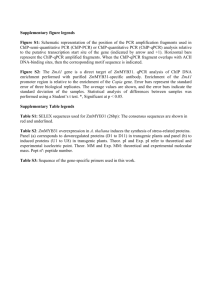References
advertisement

GMO food from transgenic animals? Lech Zwierzchowski Institute of Genetics and Animal Breeding PAS, Jastrzębiec, 05-552 Wólka Kosowska, Poland The improvement of animal production by transgenesis is expected to be complementary to other breeding techniques, including genetic selection. Projects are in progress to use transgenic animals both in agriculture and in medicine. Insertion of transgenes and other gene manipulations can improve production traits in farm animals. The most important targets for animal transgenesis are: (1) animal growth rate and meat production; (2) milk yield and milk quality; (3) wool production and quality; (4) resistance to diseases; (5) better or controlled reproduction; (6) digestion of normally nondigestable feeds or antinutrients, eg. phytic acid (less phosphate released to environment). Animal transgenesis is also a great hope for human medicine. Transgenic animals are excellent models for human diseases. Genetically manipulated farm animals will serve as producers of human pharmaceuticals – live bioreactors producing human protein medicines in milk, blood, eggs, or urine. Transgenic animals, mostly pigs will be donors of organs for xenotransplantntion. In this paper the present state of animal transgenesis is reviewed, in particular the potential of using transgenic animals as a source of food for humans. Production of biopharmaceuticals in mammary gland of transgenic animals is now a reality. Recombinant human therapeutical proteins purified from milk of transgenic animals will soon appear in pharmacies. Several human biopharmaceuticals, eg. -1-atitrypsin, antitrombin or glucosidase are now produced in amounts sufficient for commercial use and passed all necessary clinical trials; now they await FDA acceptance. Other modifications of milk composition were made on mice, the only animal for which totipotential embryonic stem cells (ESC) are available. Modification of composition of ruminants milk is a long distance target; new techniques of gene manipulations in farm animals, such as gene targeting, homologous recombination, gene knock-out, must be developed and refined before such modifications will be a reality. Attempts to use gene manipulation for increasing growth rate and meat production was a disappointment. Transgenic rabbits with human GHRH gene fused to mMT promoter obtained in our laboratory grew faster during first several weeks of life and at the age of 5 weeks were on average 30% heavier then controls (Rosochacki et al., 1992). But rabbit is of the minor importance as a meat animal, especially in Poland. In different laboratories transgenic pigs were obtained overexpressing growth hormone from gene constructs with human, bovie, or porcine sequences (Pursel et al., 1990). Some of them grew slightly faster, better converted feed, and were leaner then their non-transgenic siblings. However, they suffered from stomach ulcers, arthritis, and other disorders. Attempts to use transgenesis to increase growth of other farm animals – cattle, sheep - completely failed. The only exception is transgenic fish. Our transgenic carps with human GH gene expressed under direction of X. laevis -actin gene promoter were at the age of 1 year on average 40% heavier and 6 cm longer then the non-transgenics (Rosochacki et al., 1993). Transgenic salmons obtained by Devlin et al., (1994) and Do et al., (1992) were on average 11 times heavier then controls and some of them reached the body weight almost 35 times higher. Now, fast-growing commercial fish - salmon, carp, tilapia - endowed with all-fish GH gene constructs are produced and will soon appear on the food market; they only need agreements from relevant commissions and of course a public acceptance. Using methods of gene manipulation to increase wool growth and quality or to endow animals with disease resistance as so far is of minor importance for animal breeding and food production and need further technical improvement. Genetic manipulation of animals for food production is not only a technical problem. Public acceptance of such manipulations is necessary and safety of GMO food must be considered. It must be stressed, however, that as so far no products derived from transgenic animals, either medicine or food, are available on the market. But this situation will possibly change soon. References 1. DEVLIN R.H., YESAKI T.Y., BIAGI C.A., DONALDSON E.M., SWANSON P., CHAN W.K., 1994 - Extraordinary salmon growth. Nature 371, 209-210. 2. DU S.J., GONG Z., FLETCHER G.L., SHEARS M.A., KING M. J., IDLER D.R., HEW C.L., 1992 – Growth enhancement in transgenic Atlantic salmon by use of an “all fish” chimeric growth hormone gene construct. BioTechnology 10, 176-181. 3. PURSEL V.G., HAMMER R.E., BOLT D.J., PALMITER R.D., BRINSTER R.L., 1990 – Integration, expression and germ-line transmission of growth-related genes in pigs. Journal of Fertility, Supplement, 41, 77-87. 4. ROSOCHACKI S, SMIRNOV A, KOZIKOVA L, SADOWSKA J, JEFIMOV A, ZWIERZCHOWSKI L- 1992 - Transfer of human growth-related genes into rabbits. Animal Science Papers and Reports 9, 81-90. 5. ROSOCHACKI S.J., BIAŁOWĄS H., CZŁONKOWSKA M., GUSZKIEWICZ A., KOSSAKOWSKI M., SADOWSKA J., SIADKOWSKA E., ŻEBROWSKA T., SZUMIEC J., ZWIERZCHOWSKI L., 1993 – Introduction of human growth hormone gene into common carp (Cyprinus carpio). Animal Science Papers and Reports 11, 47-58.







